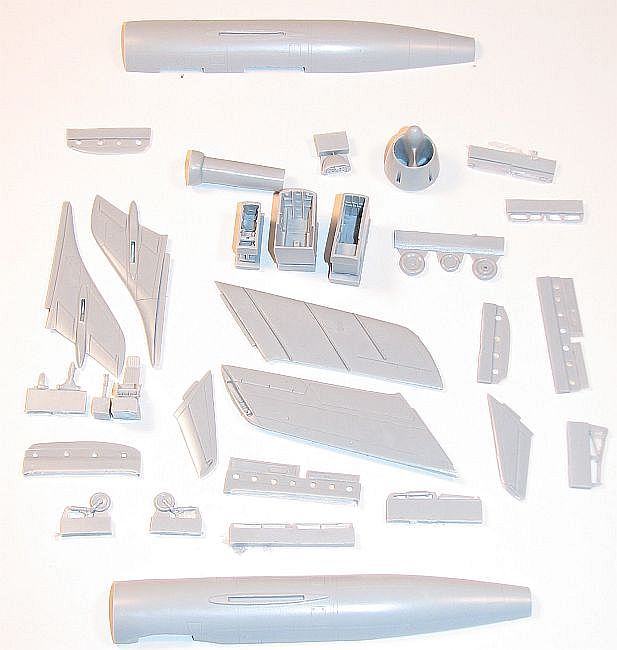
Prop & Jet 1/72 Yakovlev Yak-50
By Matt Bittner
Introduction
The Yakovlev Yak-50 was an experimental design which first flew in July, 1949. It was developed after an order was placed to Yakovlev for a lightweight, radar-equipped, all-weather and night interceptor that could fly close to the speed of sound (the official speed wanted was Mach 0.97). It was to use the same engine that was in the MiG-15 and MiG-17, the Klimov VK-1. Even though the design specifications called for the speed to be close to Mach, the first test flight the aircraft actually flew past the speed of sound, at Mach 1.03 at 10,000 feet during a shallow dive. However, there were flaws evident in the first test aircraft, namely the airbrakes were ineffective, the yaw was too much during transonic speeds which made accurate gunfire impossible, and the aircraft was difficult to land in crosswinds, and impossible on wet or icy runways. Yakovlev did make a second prototype that had a deeper "underfin" along the centerline. I'm not sure if the second prototype took care of the first's inefficiencies, but it didn't matter since the type was not selected for production, instead an upgraded MiG-17 "won" the design "contest".
The Kit
This is definitely one of the best resin kits I have ever seen. The level of detail and finesse puts it above most other resin kits – in fact, if I did not know this was a resin kit I would be inclined to believe it was injected plastic. The 1/72 Prop & Jet Yakovlev Yak-50 consists of 39 pieces of resin and two vacuformed canopies, an extra supplied "just in case". There are parts supplied to build either of the two prototypes including decals. Well, yes, decals are provided for both, but in the form of a sheet of stars and numbers that will work for these two aircraft. Decals are nicely printed and in register.
Unfortunately for those of us that don't know the language, the instruction sheet is entirely in Cyrillic. Hopefully I'll have it translated soon, at which point I will re-publish this article. Until that time figuring out colors and such - especially for the interior pieces - will have to rely on the very few remaining photos. Hopefully the translation includes color call outs for those areas.Painting the cockpit will be not as easy as some other models due to it being a deep tub. To that is added an ejection seat (which doesn't have seat belts molded in, nor included as separate items), instrument panel and control column. Plug that, the exhaust pipe and the wheel well tubs into one fuselage half then you can glue the two halves together. I can't tell if the instructions mention anything about nose weight, but I don't think it will be needed since the Yak-50 had a "tandem" landing gear arrangement. Once the fuselage halves are assembled construction continues quickly.
Prop & Jet supplies two separate vertical tail surfaces - one for each version. To this you'll add the horizontal tail surfaces before gluing the assembly to the fuselage. I'm not sure if I'll follow this step to the letter, instead add the horizontal tails after adding the vertical, taking care of any gaps (if there are any) where the vertical tail meets the fuselage. After the tail is added then the wings are glued into place. Head's up with this step. The wings were at an anhedral of four degrees down, so pay attention to that.
From here the instructions show which pieces build up each landing gear leg, including the "outriggers" on the wing tips. While the instructions would have you glue these on in the following step, they are best left off until close to the very end. The only pieces I would add prio to painting are the strakes on the underside of the fuselage. Again, these are dependent on the version you're building - two outside strakes for the Yak-50-I and a single, central strake for the Yak-50-II. If you're going to close the cockpit with the single-piece canopy (I think the canopy slid back from the windscreen, but I'm not 100% sure) I would also add it to the model now to take care of any seams that might be show up. After masking, you are now ready to paint.It appears both prototypes were - if not Natural Metal overall - then maybe the ubiquitous varnish over the natural metal. Until I can have the instructions translated I'm not sure which finish the aircraft were finished it.
Conclusion
This is an excellent kit, one that is difficult to believe it's actually resin and not injected plastic. I dry-fit the fuselage halves together along with the separate nose, and it appears in this area the fit will be as perfect as it can be. The nose-piece is even notched so you really can't mess up its placement, which is high-level molding, especially in resin. Prop & Jet have a real star on its hand with their 1/72 Yak-50. There is no doubt in my mind that if you enjoy Russian aircraft, especially experimental ones, you will do yourself a disservice if you do not purchase this model. Although they've been closed for a few weeks, I suspect you should be able to purchase this model through Linden Hill Imports in the USofA once they re-open.
Huge, huge thanks to Prop & Jet for the review model.


